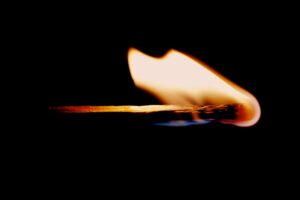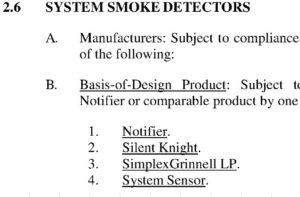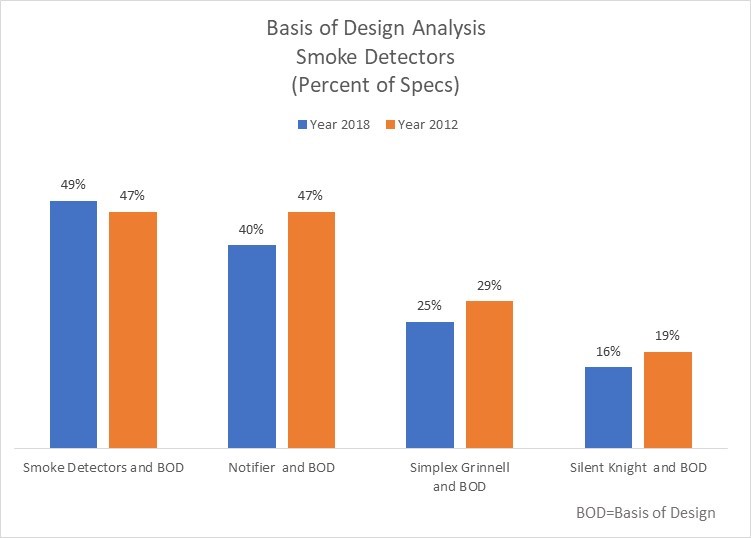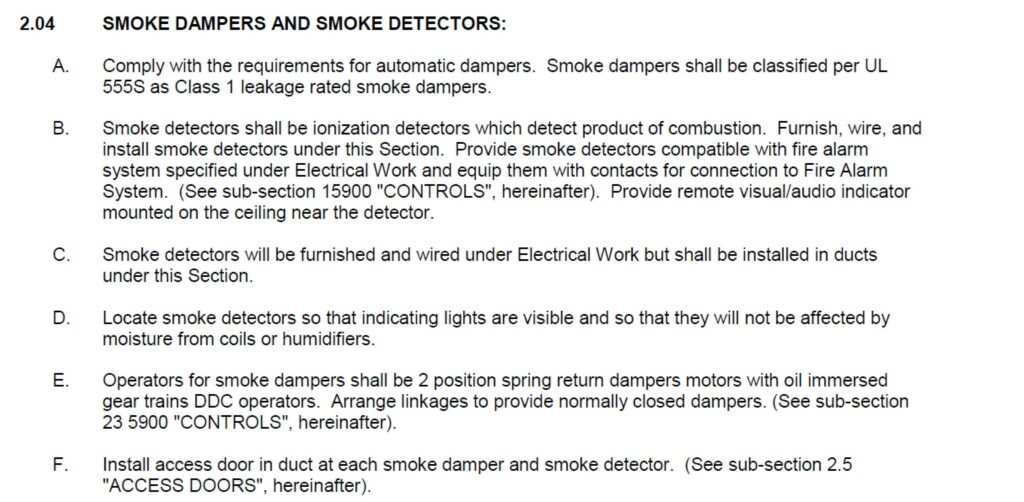
What Architects Need to Know When They Specify Smoke Detectors

While smoke detectors are only one component of a complex building fire alarm system designed to provide safety, preserve health and protect buildings, some would argue it is the most important. Smoke detectors are constantly working to detect the existence of smoke that could potentially endanger the lives of the building occupants by warning them “in time.”
There are many different types of smoke detectors designers must consider. For example, there are beam smoke detectors, duct detectors or aspirating detectors, and the designer must select the smoke detector that best meets the project’s goals. To assist designers in proper specification, it is important for these device manufacturers to keep architects up to date on their brand’s guidelines, safety record and performance standards.
According to a current 2019 report published by the National Fire Protection Association (NFPA)[1], “Fire Loss in the U.S. in 2018”, there were over 1.3 million fires in the U.S during 2018. This resulted in the death of 3,655 civilians and over 15,000 injuries. These fires resulted in property damage of over $25 billion.
In specifying smoke detectors for commercial projects, architects and designers need to make sure they not only follow the applicable codes, but that they understand the specific smoke detector applications, building requirements and any unusual conditions that may exist in the building environment. Manufacturers need to continuously connect with designers since product features and benefits change frequently.
Specifying Smoke Detectors-Meeting the Requirements
Selecting and specifying smoke detectors can be complicated. According to a recent article published by Electrical Contractor magazine titled, “Smoke Detection 101”[2], there are basically two different types of smoke detectors. One type detects invisible or slightly visible particles of smoke (ionization principle) and the other detects visible particles only using photo electric light. The first step in the specification process starts with a clear understanding of the fire protection goals of the specific project and owner.
Besides, today’s more advanced smoke detectors utilize multiple types of detection all in one device. A typical detector might include photoelectric, ionization, heat, and carbon dioxide detection. Here, the architect, while he delegates to the fire protection engineer, does well to educate himself on some of these choices, especially since some of these products are often proprietary. While there is nothing wrong with have proprietary equipment, maintenance and service should also be factored into the ultimate specification.
It is also important for the designer to consider where the smoke detectors will be placed. The placement of the smoke detectors will have a big impact on the ultimate performance of the specific type and brand of smoke detector used.
Another complex part of specifying smoke detectors is that there are many national and local fire codes that need to be addressed. Codes change based on a number of variables. For example, ICS Engineering[3] firm indicates that no two facilities are the same. The decisions and codes on the smoke detection equipment can vary based on factors such as number occupants, type of business conducted, local response times and number of floors. Choosing the right smoke detectors requires customization to building needs and applicable codes. Who, but the architect, is the ultimate arbitrator of what the client really needs?
Aesthetics
Although the particular style or appearance of a smoke detector is not nearly as important as performance and reliability, in some cases the “look” may impact the architect’s selection and specification of brand. There are some types of luxury projects that may select a particular brand based on how well it compliments their appearance. In addition, in major renovations or additions, the profile or look of a particular smoke detector may need to match or accommodate an existing footprint.
One of the best ways for fire/smoke detection manufacturers to increase their position in the market with architects is to provide design professionals with data and “real” examples of their smoke detectors long-term performance and durability by type of facility. In a 2019 Accountability Information Management, Inc. (AIM) Market Trends Research Study[4], building professionals indicated that their biggest fear in trying new brands was that the product won’t perform or last as long as promised. With actual proof of performance and durability, manufacturers have a better chance of being specified and ultimately installed. With most building products, and especially with life/safety products, it is very difficult to get designers to switch brands. Keeping design professionals updated and informed on product features and benefits is critical to a brand’s ultimate purchase – and to changing their mind on what they are specifying.
Using Spec Analysis to Strengthen a Brand’s Market Position
Many manufactures work hard to get their brand in the facility’s specification and to be included in the list of approved brands. For many manufacturers, getting a product into the specification can be a difficult task. Architects and designers do not change or review their specs often. In research conducted and published by Architect Magazine titled The Truth About Specification[5], many times architects re-use or revise existing specifications. AIM’s Brand Preference Study revealed just how competitive the smoke detector market is. In this unaided blind brand preference study architects and designers were asked to list their top three brands of smoke detectors.
There were over 10 brands or companies mentioned by architects that were “involved” with the specification of these products. Although the list of specific brands has no doubt shifted over time, the numerous choices designers have to choose from still holds true.
A brand’s market position is fairly static — unless something disrupts it. In one of AIM’s research reports – What is a Brand – we argued that “Architects are like ranchers when it comes to managing brands that they specify. While the architect may specify a variety of different manufacturers’ brands (beef), it’s the firm’s name on the door that owner hires — not the manufacturer(s). The architectural firm itself becomes the “brand” and the assurance that the products in that specification offer quality and reliability.”
In another post called “What’s Love Got to do with a B2B Brand?” the author argues one of the key ways B2B people get information about products is from their peers! They pointed out that facilities use a variety of methods to find architect/engineer firms to help them with a particular project or service they need. The cited one of AIM’s studies that indicated the method used by the higher percent of respondents was recommendations from peers/associates. Facility management people talk to each other on what works or doesn’t work. The reason they use this method is because it provides them with the most honest feedback on a firm’s performance and the quality of work.
Designers have lots of brand choices when it comes to smoke detectors and also talk to each other about brands. In fact, the recent search of specs for smoke detectors there were often at least 5 brands specified, and contractors could basically select any brand that complied with the performance requirements outlined in the specification or in the drawings.
In some cases, the list even includes “pre-approved manufacturers” as in the following two examples:


To help manufacturers evaluate their brand position in the marketplace, it is important to first understand more about an architect’s level of involvement when specifying smoke detectors. How much control or influence does the architect or designer have on selecting a particular brand of smoke detector?
How Involved Are Architects?
Looking smoke detectors, the architects’ involvement in specifying a specific brand or manufacturer can vary based on the project type, the owner’s requirements and the architect’s knowledge of smoke detection equipment. In AIM’s Architect’s Brand Preference research, 44% of the architects surveyed indicated that they were involved in selecting and specifying the brand of smoke detector. In addition, of those that were involved, 22% indicated they did not have specific brand preference.
This was a major increase since previous research which indicated only 5% had no brand preference. Could this be that the specification of smoke detectors is getting more complex and the architect delegates the brand selection to other professionals? How does the manufacturer of a component like a smoke detector penetrate the architect’s mind and demonstrate just how important that device is in the overall fire protection scheme?
While architects may indicate they have “no preference,” they are, in fact, involved in specifying and recommending commercial smoke detection equipment. It’s really up to the manufacturer to “train” the architect to “prefer” their brand. This is done through testimonials – demonstrations of usage and preference by the end users served by the architects!
For example, according to NFPA 72, there are some tests and inspections that are required by law. A commercial fire alarm must be tested once per year in order to ensure it is working and up to code. What if the manufacturer of a smoke detector brand did a research study with end users on which brand makes this easy – or which brand makes this difficult? And what if that manufacturer used this research to demonstrate to architects why they should prefer their brand?
Research is one of the best ways to bring in testimonial proof that will benefit the architect’s customer: the end user owner or developer.
The architect will in fact weigh in on the type of look or performance they want achieve. However, due to the complexity of commercial projects, architects may delegate the brand selection to “others” in the specification path. The further the manufacturer of the component moves from the architect’s sight-path, the further his brand will move into someone else’s choice.
Many design firms today maintain a list of “approved” brands that have met specific performance and quality requirements. If a manufacturer is not on “the list”, the chance of being in a specification are limited. It is becoming increasingly important for manufacturers to expose and educate architects on their product features, benefits and other services they offer the market. However, it is not impossible (i.e., the research discussed above).
Preference
Becoming a brand on the architect’s preferred list of brands is key to impacting a brand’s position in the specifications. To be on a firm’s list of approved smoke detectors, a manufacturer needs to provide more than just a quality product. They need to have a history of top performance, offer premiere service and local support for their brand. What can smoke detection manufacturers do to enhance brand selection and preference? How can manufacturers convert “no preference” answers into specifications and recommendations for their brands? These are important questions.
Impacting Brand Specification with the Basis of Design
To answer these questions, consider what we know about specifications. The key to gaining ground in specifications is to become part of the “basis of design.”[6] This means that the architect or designer is calling out a specific brand that is used to meet the objectives of the project. To learn more about how often “basis of design” is used in smoke detector specs, we used ConstructConnect™, (https://www.constructconnect.com/), an online construction database, to get a better sense of how smoke detectors are specified. By searching the projects smoke detector specifications for “smoke detector with Basis of Design,” in specific years, we can see how the specification for “basis of design” and specific brands has changed in this category.
Almost half (49%) of projects in 2018 with a smoke detector specification also included a brand as the “basis of design.” In fact, this has increased slightly since 2012 where “basis of design” was specified in 47% of the smoke detector specifications. This analysis also indicates that while only half of projects with smoke detector specification have a “basis of design” spec, there are specific brands that consistently appear as the basis of design.

Since there are a variety of different brands that are involved in delivering smoke detectors to the market, this type of spec analysis can show manufacturers how often their brand is specified as the “basis of design” and if it has shifted over a specific period of time.
Since the market is constantly changing as new and existing manufacturers introduce new products to the marketing, it is important for a manufacturer to continuously review their position in the project specifications. While a manufacturer cannot always be sure that they are on a firm’s “preferred” list, they can evaluate how often their brand appears in the specifications and measure how often they are the “basis of the design” or appear in the project schedules. If a brand is found in the specifications and is the “basis of design,” they certainly are going to be on the list of “preferred” brands.
Recent analysis of the smoke detector specs also indicates that in some specs, a specific brand can be called out. To avoid being replaced by a “less expensive” smoke detector or a “comparable” product, smoke detector manufacturers may want to strive to be specified as the brand with “no substitutions”.

In thousands of specifications, however, there is no specific brand specified.
 This is an “open door” for manufacturers not only who are the leaders, but those who want to be leaders to penetrate the architect’s mind.
This is an “open door” for manufacturers not only who are the leaders, but those who want to be leaders to penetrate the architect’s mind.
The same research can be done on the other product categories or on specific brands based on the manufacturer’s needs. AIM can design a spec analysis to meet a client’s objectives and look at a particular brand/manufacturer, by territory, competitors, project type, location or by spec area/schedule. Let us know where your interests are. Thank you, and let us hear from you!
_______________________________________________________
[1] Fire Loss in U.S. in 2018, October 2019, published by National Fire Protection Association, based on a survey of over 2,700 fire departments. https://www.nfpa.org/News-and-Research/Data-research-and-tools/US-Fire-Problem/Fire-loss-in-the-United-States
[2] Smoke Detection 101, Electrical Contractor Magazine, June 2018, Wayne Moore, Fire Protection Engineer, Jensen Hughes
[3] ICS Engineering, “Fire Alarm System Design”, http://www.icsenggroup.com/fire-alarm-systems.shtml
[4] 2019 Market Trends Study on Product Selection, October 2019, On-line survey with 170 architects, designers and facility professionals. Open-ended comments indicated over 50% of respondents feared a new product would not perform or last as long as promised.
[5] The Truth About Specification, by John Schneidawind, AIA highlights key findings on an AIA survey of 330 architects on how they select and specify building materials for commercial projects. The article stresses the importance of an architect’s relationship with building product manufacturers and report that 60% of the time the architect already knows which materials an architect is going to use.
[6]USlegal.com defines it as “Basis of design is a term used in engineering, which typically consists of text paragraphs, preliminary drawings, equipment lists, etc. Well-defined requirements consist of a set of statements that could form the basis of inspection and test acceptance criteria. The basis of design documentation and the specification identify how the design provides the performance and operational requirements of the project and its systems.”